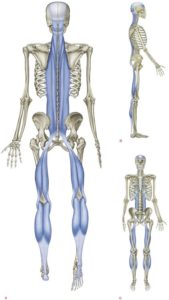It’s Not Just For Runners Anymore…
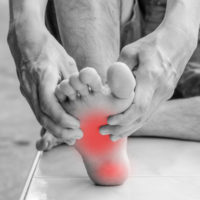 Plantar Fasciitis treatment is often ineffective. This is because the mechanism is poorly understood and the wrong tissues are often treated.
Plantar Fasciitis treatment is often ineffective. This is because the mechanism is poorly understood and the wrong tissues are often treated.
(PF) is an inflammation of the plantar fascia. It causes pain on the bottom of the foot. This is typically worse where the primary arch meets the front edge of the heel. Chronic strain of the plantar fascia causes this inflammation. The single origin point on the heel bears more force than any other point on the plantar fascia. This is why we feel it the most there.
The Plantar Fascia is a tough fibrous sheet on the bottom (plantar) side of your foot connecting the heads of the foot bones (tarsals) to the inside front corner of the heel (calcaneus). 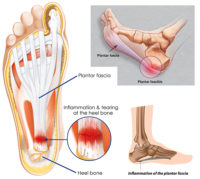 In runners the often presents as a repetitive strain injury of the attachment site of on the front of the calcaneus (heel bone). Over time the micro-attachments of plantar fascia pull the covering of the bone (periosteum) from the calcaneus, causing intense, localized pain and inflammation and in some cases leading to bone spurs.
In runners the often presents as a repetitive strain injury of the attachment site of on the front of the calcaneus (heel bone). Over time the micro-attachments of plantar fascia pull the covering of the bone (periosteum) from the calcaneus, causing intense, localized pain and inflammation and in some cases leading to bone spurs.
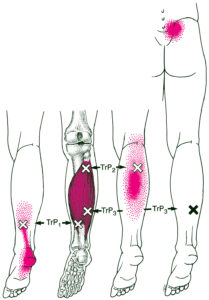 Most plantar fasciitis treatment is ineffective because it focuses on the inflammation within the foot. Why? Because the problem actually doesn’t begin with the feet and has little to do with them. Instead, there are a variety of actual causes that we will explore.
Most plantar fasciitis treatment is ineffective because it focuses on the inflammation within the foot. Why? Because the problem actually doesn’t begin with the feet and has little to do with them. Instead, there are a variety of actual causes that we will explore.Regardless of cause, we start with adjustments, if possible, in the activity that perpetuates the problem. Our treatment protocol always includes of targeted compression to the legs and plantar fascia, along with movement through the entire range of motion of the ankle.
Of course, there are many other potential factors to consider. This includes weak glutes and core muscles, restricted hip extension, stiffness in the big toe, pronation of the foot (or the entire body when running), external rotation at the hip and more. However, increasing the length of the muscles on the back of the leg is always a great starting point.
The Importance of Fascial Chains
The tissue on the bottom of the foot, including the quadratus plantae muscle and plantar fascia is part of a “fascial chain” that includes the calcaneus, the long, powerful muscles of the calf and hamstrings. We use large muscles in our legs to generate massive forces through the legs to the feet. Then, we distribute this force between the foot and the surface of the ground as we walk or run. The “end of the road” for this chain is the plantar fascia.
Of course, we are designed for this force delivery, so what is happening when PF develops? Normally, we deliver force dynamically from the legs to the PF. Along with other connective tissue, this acts as a spring and returns energy back to the legs. However, problems develop when the underlying activity, such as running, begins to cause shortening of the muscles in the legs. Unfortunately, this is problematic because the force of the contracted leg muscles is now being delivered statically to the PF. In fact, the “spring” of the foot is being pulled on continuously when at rest, without an opportunity to return the force anywhere.
In addition, if you place any part of your body into a gentle, painless stretch position and keep it that way for hours a day, you will develop soreness and inflammation in the stretched tissue. So it is no surprise that happens to our feet. In this thought experiment, we can imagine that we would probably alleviate this pain by simply moving out of the stretched position. But when our leg muscles are pulling continuously via the kinetic chain through the heel to the PF, we can’t simply reposition ourselves to relieve the stress.
Traditional Plantar Fasciitis Treatment
Over time, no amount of conventional massage, ultrasound, cortisone or other conventional plantar fasciitis treatment to the foot is likely to help because the foot is largely the victim of the leg muscles. The key is to treat the leg muscles, releasing taut bands and trigger points that have shortened these muscles and reduced their range of motion. It is not uncommon for runners to roll out their calves to prevent of treat PF. It is a great beginning, but not enough.
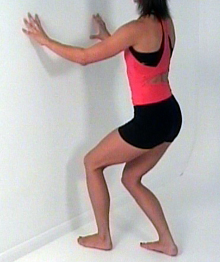 Myofascial Plantar Fasciitis Treatment
Myofascial Plantar Fasciitis Treatment
We typically need to provide targeted compression to trigger points in the calf, especially the soleus in the lower calf. There may also be taut bands in the gastocnemius and even the hamstrings, which in turn pull on the gastroc. Following treatment of all of these muscles, it may also be helpful deeply and gently compress the bottom of the foot – try keeping a golf ball under your desk at work! This will help to loosen the plantar fascia and quadratus plantae and take advantage of the reduced tension delivered from the legs.
It is also vitally important to run the muscles through their full range of motion, passively stretching AND shortening them. Any basic calf stretch is a helpful but tends to focus on the gastroc rather than the deeper soleus. Note that in this calf stretch variation, the knee of the leg being stretch is bent. This focuses the stretch on the soleus rather than the gastroc. A mere 1% increase in length in the tissues from the knee down is a .25 inches, far more than any passive stretch that could ever be applied and maintained to the bottom of the foot.
I’m Not Athletic – How Did I Get Plantar Fasciitis?
 Now, let’s consider a couple of ways this can happen without athletic activity. Perhaps you are relatively short. When you are working you sit at a desk and need to raise your chair to use the computer effectively. Your feet don’t touch the floor, your ankles and feet dangle (plantar flexion) and point down to the ground. If you wear high heels, the calf muscles are shortened continuously.
Now, let’s consider a couple of ways this can happen without athletic activity. Perhaps you are relatively short. When you are working you sit at a desk and need to raise your chair to use the computer effectively. Your feet don’t touch the floor, your ankles and feet dangle (plantar flexion) and point down to the ground. If you wear high heels, the calf muscles are shortened continuously.
On the other hand, you might be tall, with a well made bed, top sheet tucked in at the bottom, near your feet, and blanket or comforter on top. If you are sleeping on your back, the covers will push your ankle into plantar flexion and point your feet down relative to your legs, the same as the office worker.
If you are sleeping on your stomach, the bed coverings don’t matter, your ankles are always plantar flexed in this position. In all these cases, the muscles of calf are now shortened for hours, eventually causing PF is a manner very similar to athletes.
Additional factors, such as limited hip extension, tightness in the external hip rotators or pronation of the feet can be professionally treated.

